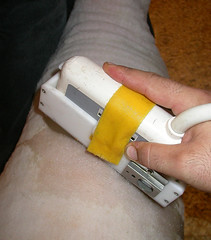 Before transport to slaughter, loin eye area, loin depth, and backfat thickness were measured from transverse ultrasound images taken between the 12th and 13th ribs. After slaughter, the same measurements were taken on each carcass. Carcasses were fabricated into subprimal cuts and weights were recorded.
Before transport to slaughter, loin eye area, loin depth, and backfat thickness were measured from transverse ultrasound images taken between the 12th and 13th ribs. After slaughter, the same measurements were taken on each carcass. Carcasses were fabricated into subprimal cuts and weights were recorded.Ultrasound bias approached 0 for loin eye area. Backfat thickness was overestimated by only 0.69 mm (0.03 in.). At a standardized body weight and backfat thickness, wethers with larger loin eye area and loin depth depth yielded larger and more valuable carcasses, and these relationships were detectable with ultrasound.
The data indicate biological and economical incentives for increasing loin eye area in wethers, and live-animal ultrasound can provide reliable estimates of carcass measures. These results are applicable to terminal sire breeders and producers who market sheep using carcass-merit pricing systems.
Source:Journal of Animal Science, November 2008. Read abstract
